Are you looking for creative ways to get your classroom outside this spring? The Great Wisconsin Birdathon is the perfect opportunity to engage your students in the natural world and get them excited about bird conservation. Learn how the Birdathon can make an impact in your classroom—all while your classroom makes an impact #ForTheBirds!
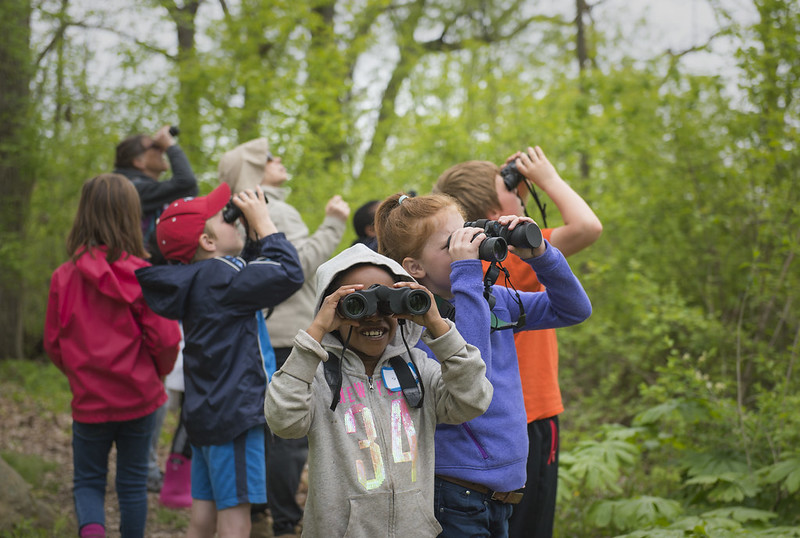
Students explore birding at the 2017 Outdoor Education Summit. Photo by Madison School and Community Recreation
What is the Great Wisconsin Birdathon?
The Great Wisconsin Birdathon is the largest fundraiser for bird conservation in Wisconsin. It runs each spring from April 15 to June 15. Interested participants form a team, gather donations with the help of friends and family, and then go birding on their day of choice to see how many species they can find.
Proceeds from the Birdathon go to the Natural Resources Foundation’s Bird Protection Fund, which supports high priority bird conservation projects in Wisconsin, like those that protect Whooping Cranes, Kirtland’s Warblers, Piping Plovers, and more.
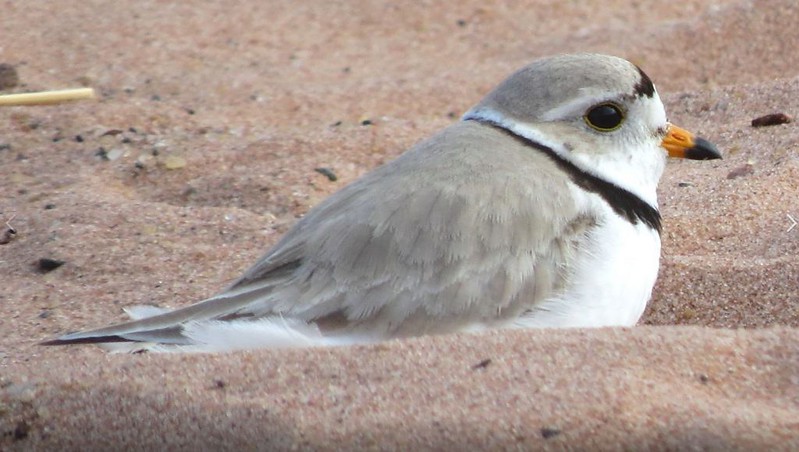
The adorable Piping Plover was voted as the Great Wisconsin Birdathon’s 2021 Bird of the Year! Photo by Anne Geraghty
The Great Wisconsin Birdathon is for everyone, regardless of their experience with birding. While we encourage teams to report how many species they can find, the Birdathon is not a competition—it’s about Wisconsinites across the state coming together #ForTheBirds.
For classrooms in particular, the Birdathon is more than just a fundraising event—it’s an opportunity for your students to discover a new passion and learn more about environmental conservation. Even if your classroom isn’t able to fundraise just yet, we’d still love for you to participate!
Up next, we’ve got some classroom testimonials, tips for planning your classroom Birdathon, and resources for teachers who’d like to incorporate bird conservation into their curriculum.
What the Birdathon Can Bring to Your Classroom
Participating in the Great Wisconsin Birdathon can help your classroom meet Wisconsin’s environmental education standards. The Birdathon provides a tailored opportunity for students to connect, explore, and engage in the world around them.
Students can connect with their sense of place and well-being as they explore their backyards, favorite parks, or school playground. Looking for birds will help them observe the world around them, explore, and ask questions about nature. A sense of curiosity and wonder comes hand in hand with birdwatching—and so does a whole lot of fun!
In 2020, we had two classrooms participate in the Great Wisconsin Birdathon: Dave Sisler’s 4th grade class participated at Windsor Elementary for the first time and Peter Dargatz’s kindergarten class at Woodside Elementary returned for their third Birdathon.
Mr. Dargatz’s class took advantage of their outdoor classroom—though their birding didn’t just stay at school, as students were excited to bird at home and get their families involved. “It really is a home and school partnership,” Dargatz writes.
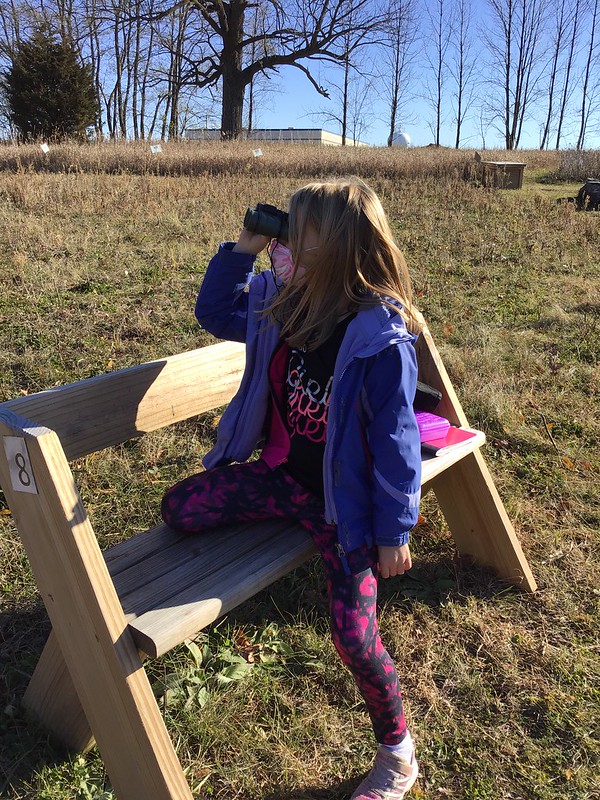
A student in Mr. Dargatz’s Nature Kindergarten birds from a Leopold bench in their outdoor classroom. Photo by Peter Dargatz
Mr. Sisler’s 4th graders and Mr. Dargatz’s kindergarten students are great examples of what is at the heart of the Great Wisconsin Birdathon—connection. “Kids love feeling connected to the natural world and find that they have strengths they never knew were of value,” Sisler says. “Because of birding, we feel more connected as a class and with our planet.”
The Great Wisconsin Birdathon can bring that connection to your classroom—it can get you and your students outside, increase classroom engagement, encourage environmental stewardship, and deepen personal development as students discover new passions for nature.
Planning Your Classroom’s Birdathon
The sky is the limit when it comes to how you Birdathon! Traditionally, teams choose one day to participate between April 15 and June 15, but we encourage your classroom to bird your way! Below are some ideas for how you might plan your Birdathon.
1. Weekly birding—together or apart!
Instead of focusing on a single day of birding, consider how your classroom might set aside time each week to observe birds throughout the Birdathon. Whether students are together at school or learning virtually at home, they can explore their immediate surroundings—at the playground or out a window.
Peter Dargatz’s classroom took this approach and opted to bird throughout the entire two months of the Birdathon, at different times of day and in different conditions. “This allow[ed] for wonderful discussions and observations about why we might be seeing differences in the birds we see and hear,” Dargatz writes. This activity pairs well with a nature journal or sit spot, where students can keep track of their bird sightings, but also other seasonal changes they notice—from the flowering of the trees to the activity of the squirrels and chipmunks.
2. Be community scientists!
The Birdathon can be an opportunity to learn more about community science and how it supports bird conservation by providing data for research. Consider having your class visit a nearby “birding hotspot” and upload their bird sightings to eBird, a community science platform for bird observations.
Because the Great Wisconsin Birdathon is a fundraiser specifically for bird conservation, it lends itself well to exploring the discussions about why conservation matters and how students can make a difference. You might also have your students explore the projects that are funded by the Bird Protection Fund while they think about the actions they can take at school or at home to help birds—from making bird feeders to putting up window decals to deter bird collisions.
3. Start a friendly classroom challenge!
Is there another class at your school also studying birds? Consider adding a dash of competition to the mix by challenging another classroom to participate in the Birdathon too! Each classroom can think about where and when they’ll go looking for birds, then compete to see who can find the most species in their chosen locations.
If students are excited about fundraising, they can see how much money they can raise—every penny counts, so don’t underestimate the power of something as simple as a penny drive! Have your students come up with slogans and make signs about protecting Wisconsin’s endangered bird species that will get their family, friends, and schoolmates excited to contribute.
These are just a few of the ways that you can bring the Birdathon to your classroom, but there are endless options that can be as involved or as spontaneous as you like—what matters is that kids get excited about birds!
You have the freedom to make the Birdathon your own—whether it’s a planned day, weekly birding, or a single, spontaneous birding outing in the playground. Let your students explore and see what they can find!
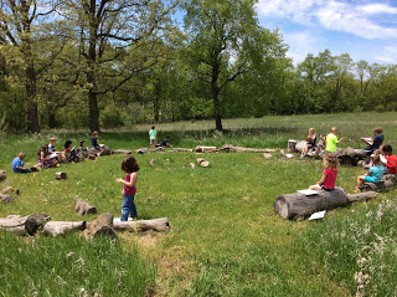
A scene from Mr. Dargatz’s Nature Kindergarten. Photo by Peter Dargatz
All the Birdy Resources You Need
If you’re not familiar with birding yourself, it can be daunting to think about how to bring it into your classroom. We’ve collected some resources to support you and your students at whatever stage you find yourself at. The Great Wisconsin Birdathon doesn’t ask anyone to be an expert—this is an event for everybody, no matter their experience!
Get Started with Birds and Birding
Your biggest challenge may be knowing how to identify birds you and your students find. Don’t let this slow you down, because there are some affordable and free ways to explore Wisconsin’s birds.
- Be sure to check out Madison Audubon’s Bird Guide for Kids, which features Wisconsin-specific birds kids can expect to see at school or home. You can order these printed guides for your classroom for a very small fee, or you can access the PDFs to explore the guide online for free.
- For online learning, you can explore birds through EEK! Environmental Education for Kids, a Wisconsin-specific site that helps teachers and students learn about our state’s natural resources.
- Or you can browse the Cornell Lab of Ornithology’s All About Birds website, which features an easy to navigate and comprehensive guide to learning about bird species.
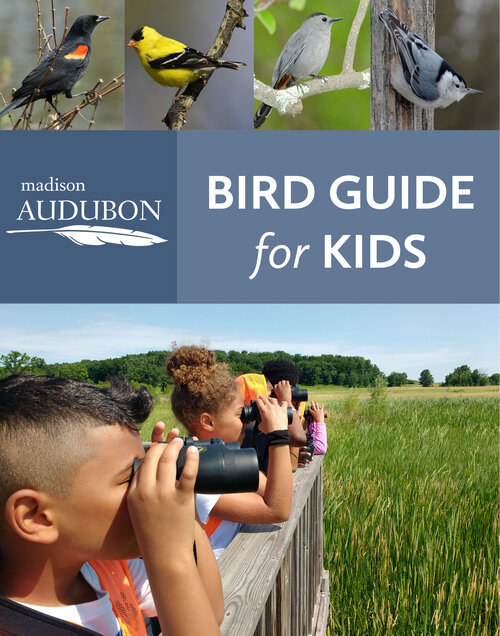
The Bird Guide for Kids is tailored for Wisconsin species that students might find at school or home! Cover photo by Madison Audubon
Free Lesson Plans
If you’d like to incorporate bird-themed lessons into your curriculum to align with the Birdathon, there are lots of free lessons available that meet Wisconsin’s environmental education standards, Next Generation Science Standards, and Common Core State Standards for English Language Arts and Math.
Here are some to get you started:
- Madison Audubon has free lessons for outdoor learning about birds, nature journaling, and more.
- The International Crane Foundation has a series of free K-12 activities all about crane species, like Wisconsin’s Sandhill and Whooping Cranes.
- Audubon Adventures, offered by the National Audubon Society and designed for Grades 3-5, features free lesson plans that meet national standards, a teacher’s guide, in-class and virtual activities, quizzes for students, an assessment guide, and more.
- The Cornell Lab of Ornithology’s K-12 Education Activities, which are split up by grade level, include free curricula that meets education standards. They include everything from fully designed units to one-off lessons, with teacher’s guides, worksheets, and more.
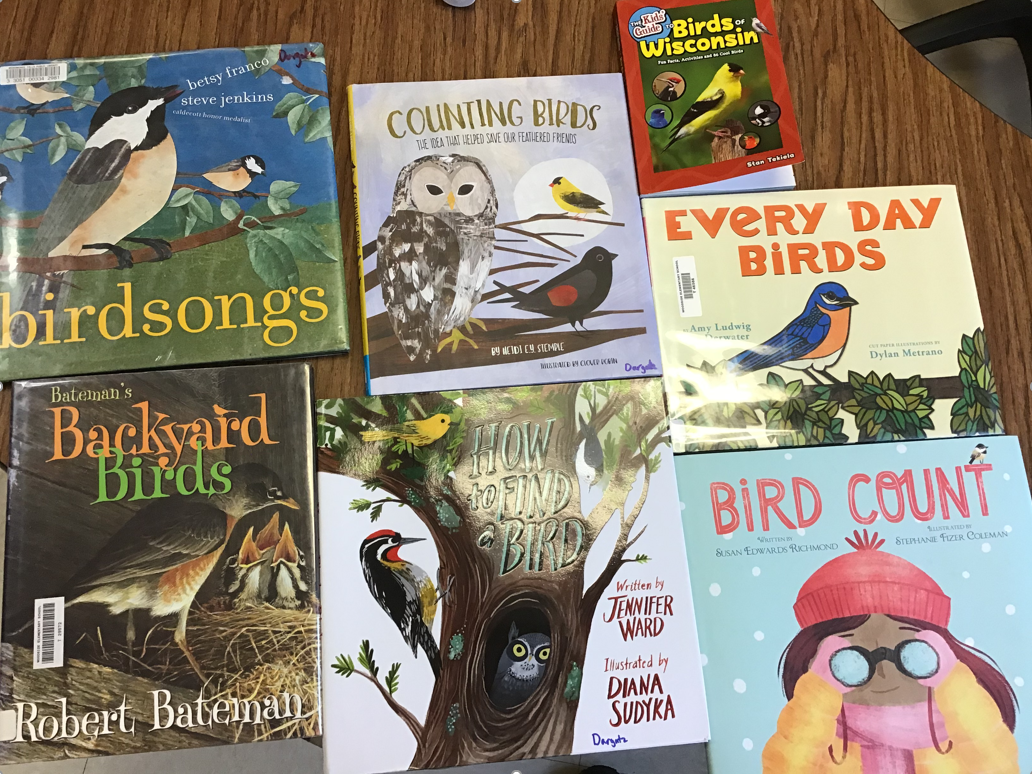
There are a lot of bird-themed books, especially for younger audiences, that are perfect for storytime. Here’s a selection of some favorites from Mr. Dargatz’s kindergarten class. Photo by Peter Dargatz
More Classroom Resources
- The Natural Resources Foundation offers grants to classroom educators through the Go Outside Fund and Teachers’ Outdoor Fund. If your classroom needs help purchasing binoculars or funding to get your students outdoors, consider applying for a grant. Learn more here.
- If you want to make outdoor environmental education a priority in your classroom but are unsure where to start, consider connecting with Field Edventures. Field Edventures works with educators to help create opportunities for outdoor learning.
Is Your Classroom Ready to Join?
The Great Wisconsin Birdathon provides an opportunity for students to experience the joy of birding, to support conservation efforts here in Wisconsin, and to think about their role in protecting our feathered friends. We hope that you’ll join us by creating a team for your classroom this year!
If you’re ready to get started, you can learn more and register your team at www.WIBirdathon.org.
If you have questions and want to learn more about participating with your class, please contact us at WIBirdathon@wisconservation.org
Written by Caitlyn Schuchhardt, Outreach Coordinator